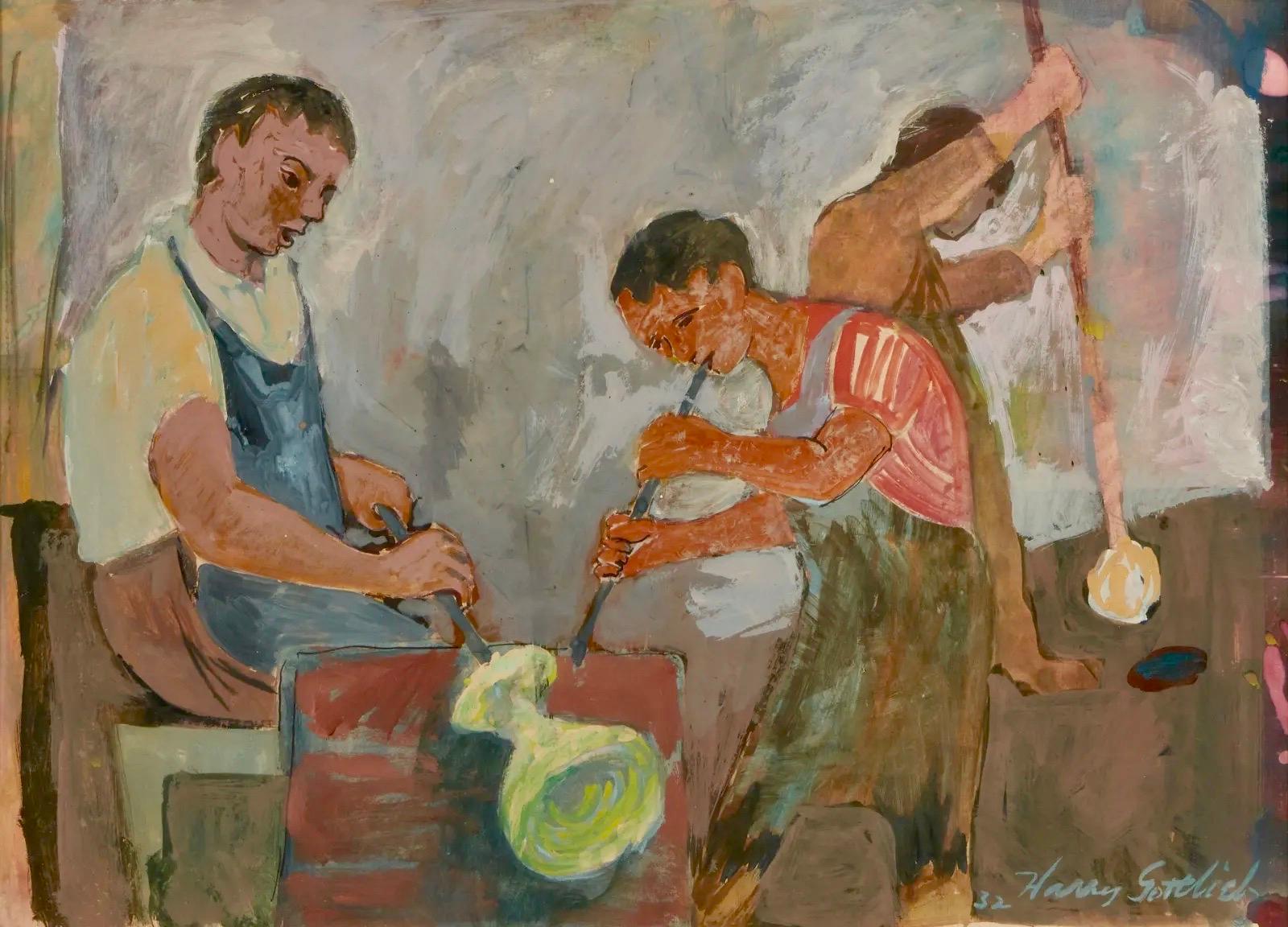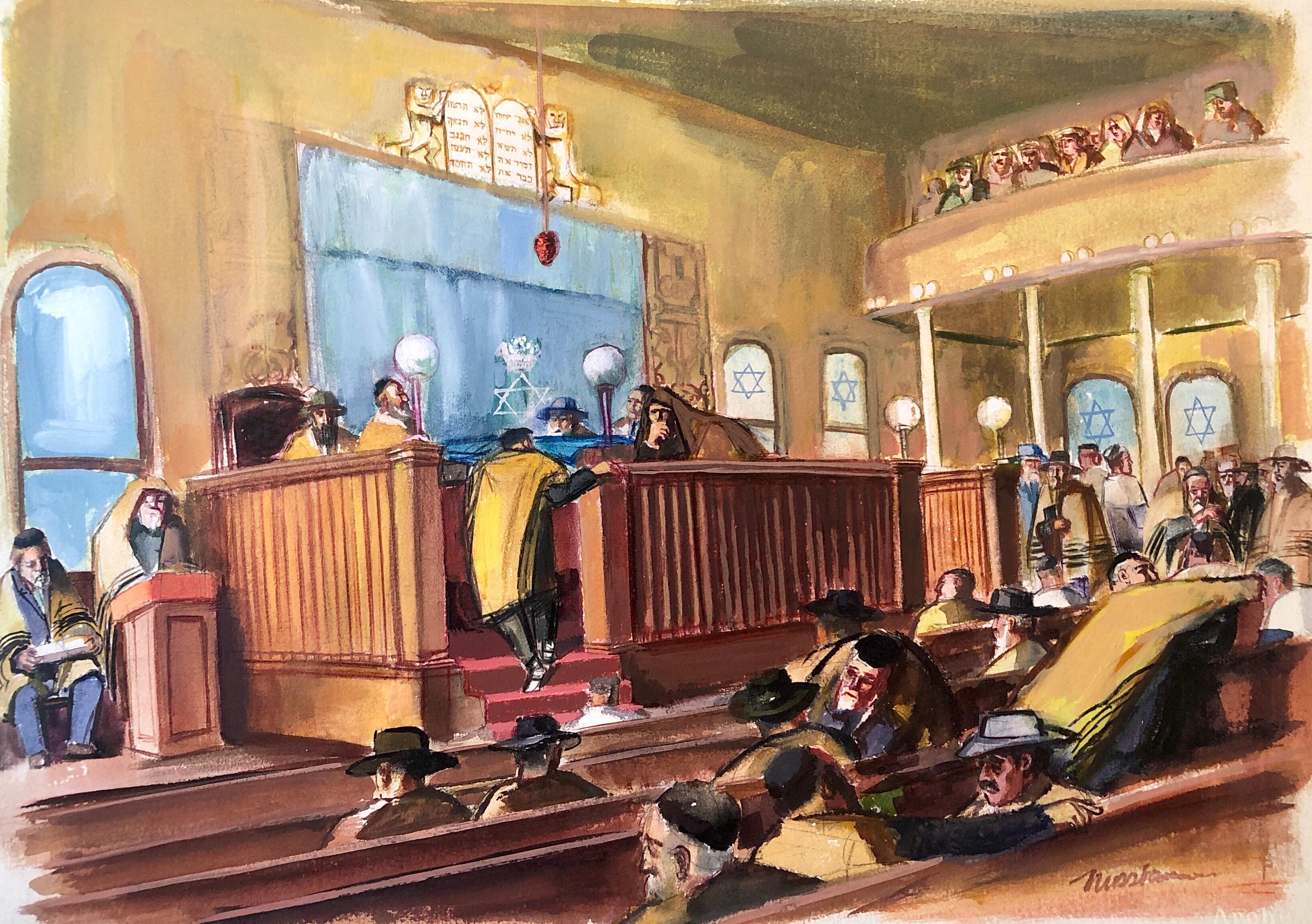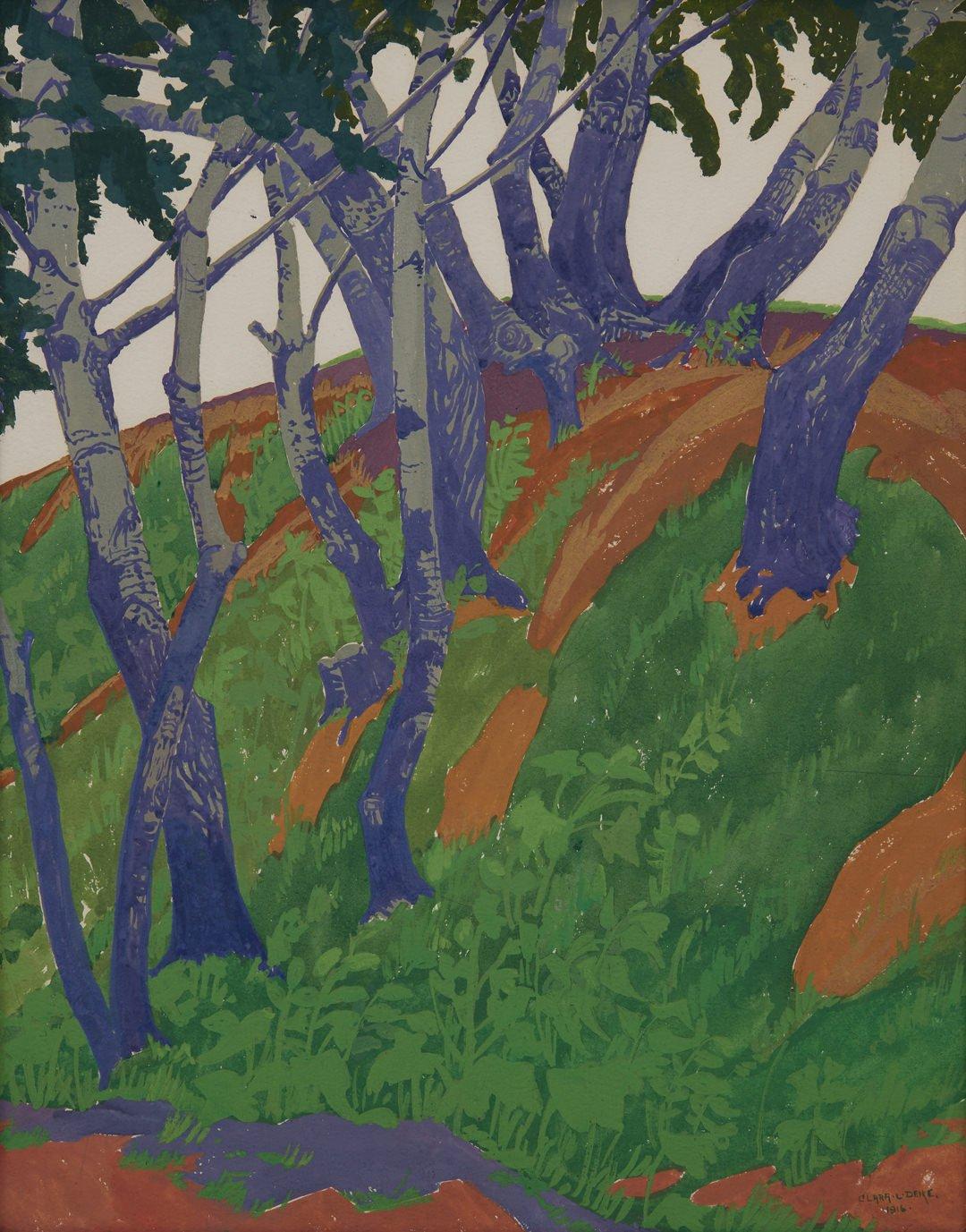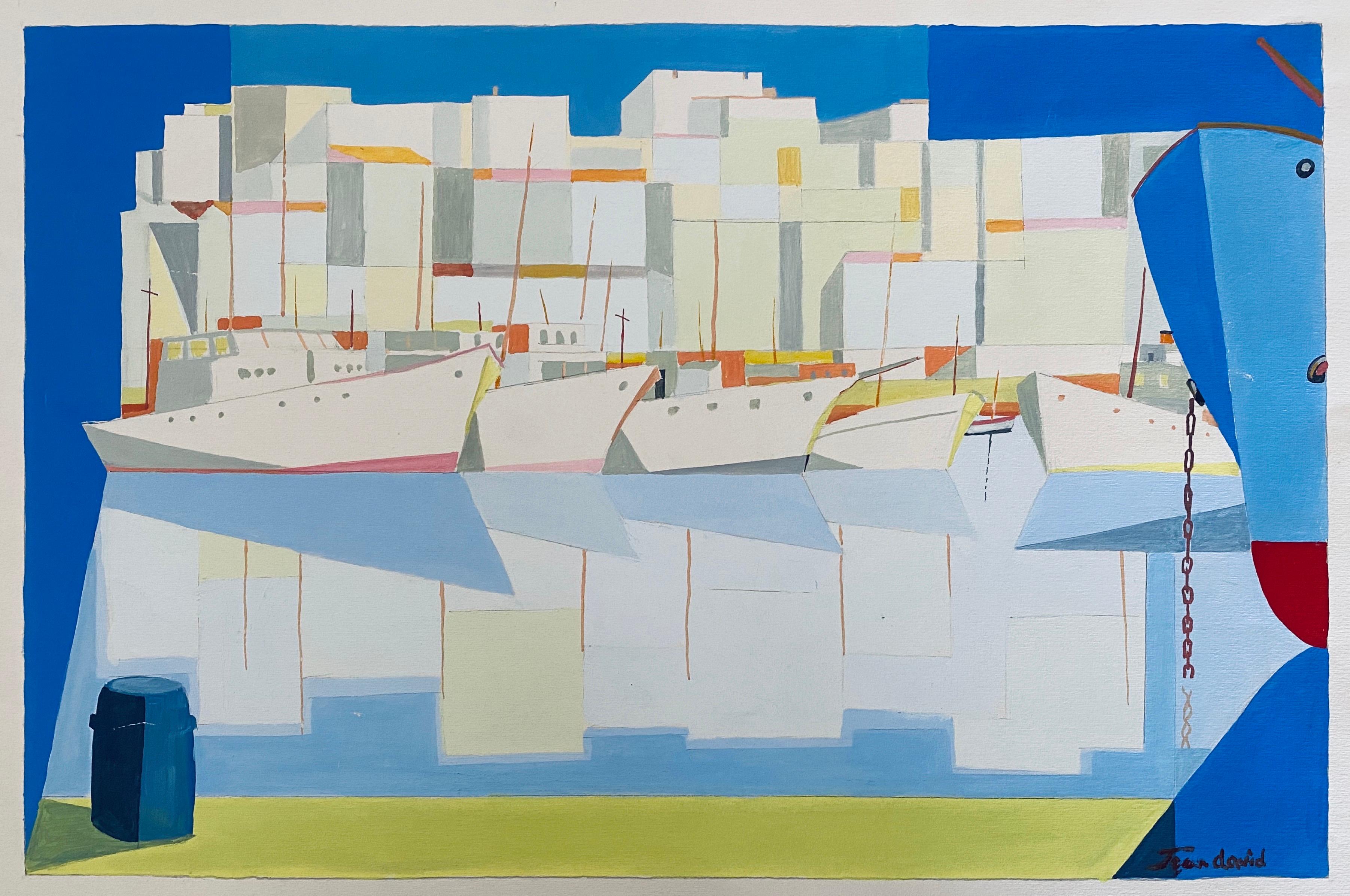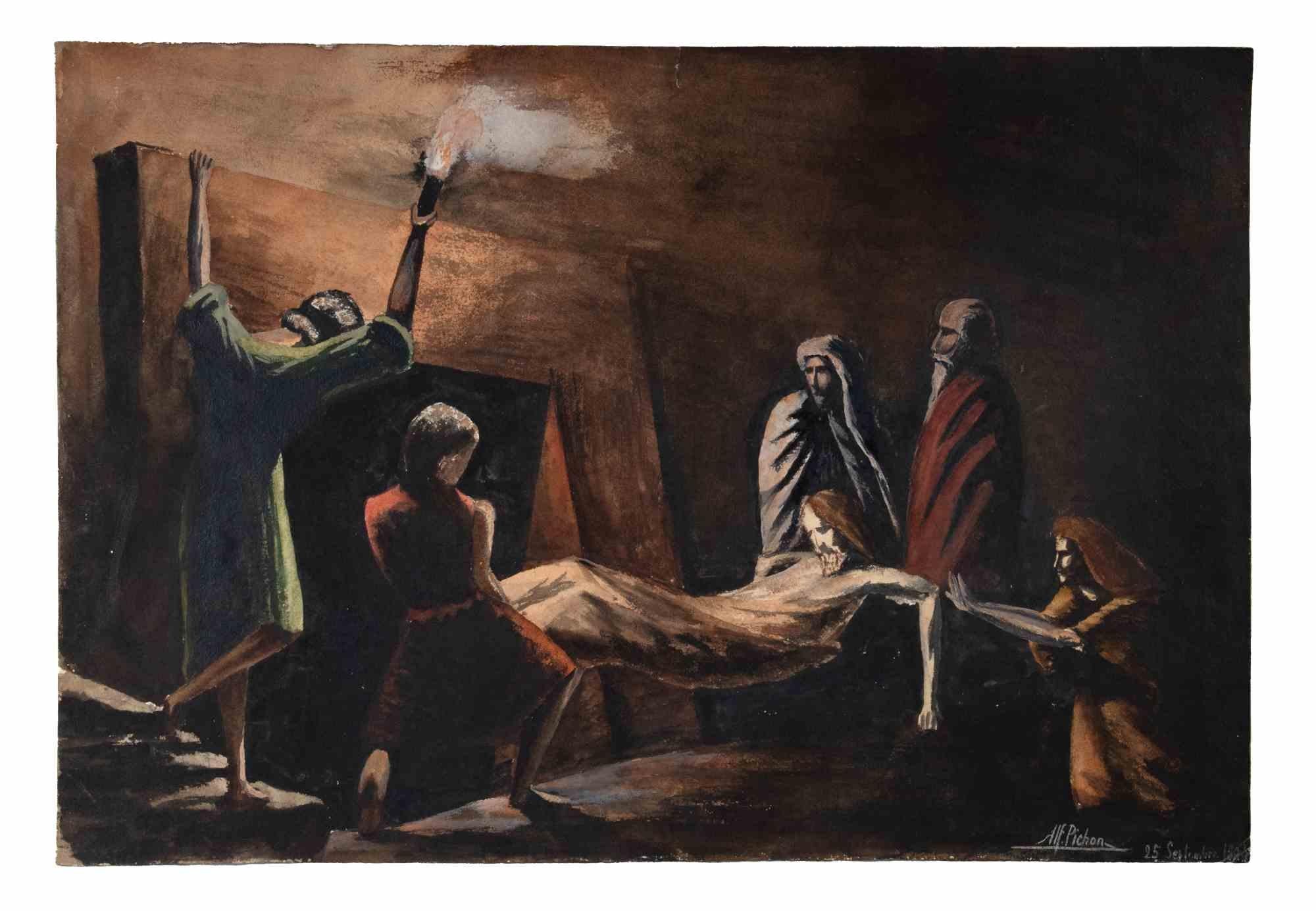Items Similar to Modernist American Judaica Painting Purim, Dancing on Haman
Want more images or videos?
Request additional images or videos from the seller
1 of 9
Ervin B. NussbaumModernist American Judaica Painting Purim, Dancing on Haman
About the Item
In this painting, Nussbaum portrays a joyful holiday celebration of the megillah reading in the synagogue in a sketch-like manner without focusing on any specific details. The vibrant colors used in this painting seem to overlay each other without being previous mixed. A jewish man celebrating Purim in a semi-abstract manner using vibrant colors in a gestural manner. This artwork exemplifies the artist's oeuvre and concentration in Hebraic themes.
Ervin B. Nussbaum was born in Columbus, Ohio on November 11, 1914. His father, Marger, had arrived as part of the great Russian Diaspora of the time, when many Jewish families settled in Ohio, particularly in the Columbus area.
Nussbaum attended Ohio State University during the Great Depression and continued to live in Ohio until America’s involvement in World War II. His oil painting The End of John Brown, which depicts a fictionalization of the American abolitionist’s final hours, won first prize at the Central Ohio Competition in 1941. The piece then toured the country stopping at the San Francisco Museum, the Butler Art Institute, the Philadelphia Academy and the Corcoran Gallery. Donated in 2001, the painting is now part of the permanent collection at the Torrington Historical Society in Torrington, Connecticut, John Brown’s birthplace.
When the war began, Ervin, along with some 40,000 other men of all faiths, became part of the conscientious objector program known as the Civil Public Service. He spent the years 1942 through 1946 interned in government camps from New Hampshire to Maryland, working in public services such as forestry and hurricane cleanup. Many other objectors housed alongside him were of artistic inclination and shared Nussbaum’s conviction of peace, so artistic pursuits were common within these camps.
During these early years, his paintings followed a somewhat whimsical figurative style and leaned towards patriotic and Hebraic themes. In time, these themes began to take on an almost Cubist feel and eventually leaned toward complete abstraction.
Upon his release from his voluntary conscription as a CPS, Nussbaum moved to New York where he frequently painted semi-abstract landscapes in the local parks, throughout the New England countryside, and at the shorelines. He especially enjoyed painting in the woodland tranquility of Inwood Park in northern Manhattan. He paid special attention to the park’s bird life, which would soon become a new favorite subject. Their graceful movement inspired his creation of a series of avian sculptures in wood, metal or mixed medias.
In 1951, he met the dynamic young actress, playwright, musician, and graphic artist Muriel Leventhal. They married and moved to Norwalk, Connecticut in 1959. Nussbaum continued to work in a variety of media and showed regularly in many different galleries throughout Connecticut. His bronze sculpture Three Girls on a Flower was commissioned by the Trumbull Library and a wood bas-relief was created for the sanctuary at the Yonkers Temple Emanuel. Nussbaum would remain in Norwalk until his death in 1996.
When contemplating the work of Ervin Nussbaum, we find the soul of a man set in principles of profound religious and patriotic convictions as well as a deep abiding love of nature. His art shows us the evolution of the man through the evolution of the styles he undertook during his lifetime; from figurative, to cubist, to complete abstraction; from oils, to charcoal, to a mixture of media. His works are left to us in museums across the United States, as well as in countless private collections in the U.S. and abroad.
- Creator:Ervin B. Nussbaum (1914-1996, American)
- Dimensions:Height: 16 in (40.64 cm)Width: 19 in (48.26 cm)
- Medium:
- Movement & Style:
- Period:
- Condition:minor wear to frame.
- Gallery Location:Surfside, FL
- Reference Number:
About the Seller
4.9
Platinum Seller
These expertly vetted sellers are 1stDibs' most experienced sellers and are rated highest by our customers.
Established in 1995
1stDibs seller since 2014
1,565 sales on 1stDibs
Typical response time: 1 hour
- ShippingRetrieving quote...Ships From: Surfside, FL
- Return PolicyA return for this item may be initiated within 3 days of delivery.
More From This SellerView All
- Modernist American Judaica Painting Synagogue Interior Ladies Section WPA EraBy Ervin B. NussbaumLocated in Surfside, FLTitled Torah Service, hand signed on Arches archival paper. In this painting, Nussbaum portrays a joyful holiday celebration of the Torah reading in the synagogue in a sketch-like m...Category
20th Century Modern Figurative Paintings
MaterialsGouache
- Romanian Modernist Gouache Painting Of Buildings And Boats - Jean DavidBy Jean DavidLocated in Surfside, FLJean David was a painter and designer, known for his contributions to the Romanian avant-garde and to the early modernist art of Israel (then recently founded). He was the first Israeli artist to be inducted into the illustrious Alliance Graphique Nationale in 1954. He had studied between 1927 and 1937 at various art academies in Paris. In 1929 he participated for the first time at a collective exhibition in Bucharest and in 1933 he had his first personal exhibition (in the same city). In the early '30s he was a member of the Surrealist group "unu" (meaning "one"). In 1942, he left Romania in a boat with 12 other Jews, including Theodor Brauner, the brother of Victor Brauner. After being captured by British authorities in Cyprus, he managed to reach Palestine in 1944. In 1949 he went to live in Jerusalem, where he was active in developing ceramic arts, sculpture works in copper, and artistic tapestry wall hangings under the auspices of the Ministry of Trade and Industry. Together with Marcel Janco, he founded in Israel the artist village known as Ein Hod. He also gained much reputation as a muralist and graphic and poster designer, having designed numerous posters and other works for the El Al air company, Maccabiah games, Zim shipping and The Israel tourist industry. David’s primary importance was in the design of posters. He used a wildly colorful decorative style in his art, which combined illustration, caricature, and national figures. In addition he designed wall hangings for “Maskit,” and also worked in the decoration of public buildings. His paintings had elements of Surrealism and included images from nature and landscapes. Similar in style to David Klein and the Polish Cyrk posters. Forms From Israel, Mounting Exhibition, USA, 1958 Artists: El Hanani (Sapozhnikow), Arie Azaz, Nehemiah Boris Carmi, Hanna Harag Zunz, David, Jean David Gumbel, Keiner Forcheimer, Julia Mansfeld, Al Merom, Peter Mayer, Jean Palombo...Category
Mid-20th Century Modern Figurative Paintings
MaterialsGouache, Paper
- Russian French Judaica Jewish Gouache Painting Sephardic Rabbi, Jerusalem IsraelBy Mane KatzLocated in Surfside, FLMané-Katz (1894 - 1962) SCHOLARS AT STUDY Signed Mané Katz (lower right) Tempera (gouache) on paper laid down on card. 19 3/4 by 23 5/8 in. (50.2 by 60.1 cm) sight size. Frame size is 27 X 31 inches. Provenance: Sotheby's Impressionist & Modern art, 8 June 2017 (consigned by original owner who purchased it directly from artist) Mane-Katz (1894-1962) was a Litvak painter born in Ukraine best known for his depictions of the Jewish shtetl in Eastern Europe. Emmanuel Mané-Katz (Hebrew:מאנה כץ), born Mane Leyzerovich Kats (1894–1962), was a Litvak painter born in Kremenchuk, Ukraine, best known for his depictions of the Jewish shtetl in Eastern Europe. Particularly music figures and Jewish wedding scenes. Mane-Katz moved to Paris at the age of 19 to study art, although his father wanted him to be a rabbi. During the First World War he returned to Russia, at first working and exhibiting in Petrograd; following the October revolution, he traveled back to Kremenchuk, where he taught art. In 1921, due to the ongoing fighting in his hometown during the civil war, he moved once again to Paris. There he became friends with Pablo Picasso and other important French artists, and was affiliated with the art movement known as the School of Paris; together with other outstanding Jewish artists of that milieu, he is sometimes considered to be part of a group referred to specifically as the Jewish School of Paris. Includes Russian, Ukrainian and Polish painters Jankel Adler, Arbit Blatas, Marc Chagall, Jacques Chapiro, Michel Kikoine, Pinchus Kremegne, Sigmund Menkes, Jules Pascin, Issachar Ryback, Jacques Lipchitz,Chana Orloff, and Ossip Zadkine. Ecole de Paris In 1931, Mane-Katz's painting The Wailing Wall was awarded a gold medal at the Paris World's Fair. Early on, his style was classical and somber, but his palette changed in later years to bright, primary colors, with an emphasis on Jewish themes. His oils feature Judaic Hasidic characters, rabbis, Jewish musicians, beggars, yeshiva students and scenes from the East European shtetl made famous in the west by Sholem Aleichem and Tevye. Mane-Katz made his first trip to Mandate Palestine in 1928, and thereafter visited the country annually. He said his actual home was Paris, but his spiritual home was Eretz Yisrael, the Land of Israel. In 1939, as World War II was breaking out, he was drafted by the French and then was taken prisoner by the Germans. He escaped and went to the United States and remained there until 1945, exhibiting his paintings at Katia Granoff Gallery and Wildenstein Gallery. After the war, he returned to Paris where he had exhibited in the Salons. In Paris to the end of his career, he worked happily, painting hundreds of portraits of rabbis...Category
Mid-20th Century Modern Figurative Paintings
MaterialsTempera, Gouache
- Modernist Judaica Jewish Ink Drawing Painting "New Immigrant" Off the Boat WPABy Ben-Zion WeinmanLocated in Surfside, FLAn ink drawing Judaic painting by modern artist Ben-Zion Weinman. It depicts a portrait of an old Jewish man. Coming over from Europe on a ship crossing. The work is signed "Ben-Zion". Born in 1897, Ben-Zion Weinman celebrated his European Jewish heritage in his visual works as a sculptor, painter, and printmaker. Influenced by Spinoza, Knut Hamsun, and Wladyslaw Reymont, as well as Hebrew literature, Ben-Zion wrote poetry and essays that, like his visual work, attempt to reveal the deep “connection between man and the divine, and between man and earth.” An emigrant from the Ukraine, he came to the US in 1920. He wrote fairy tales and poems in Hebrew under the name Benzion Weinman, but when he began painting he dropped his last name and hyphenated his first, saying an artist needed only one name. In 1920 he settled in America, where he found little interest in his writing. He began teaching Hebrew to support himself and then in the early 1930s returned to painting. He used his art to comment on the rise of fascism in Europe, events he felt could not be adequately explored with words. Largely self-taught, Ben-Zion visited the museums of New York City to learn his new trade. His first painting on a large scale, Friday Evening (1933, Jewish Museum, New York), depicts a Sabbath dinner table as recalled from his family home. Ben-Zion supported himself by working odd jobs until the establishment of the Works Progress Administration's Federal Art Project. Under the auspices of the wpa, Ben-Zion thrived and galleries began to show his work. In 1936, after his first one-man show at the Artists' Gallery in New York Ben-Zion was a founding member of “The Ten: An Independent Group” The Ten” a 1930’s...Category
1940s American Modern Figurative Paintings
MaterialsWatercolor, Gouache
- Americana Farmer and Wife, Gouache Painting WPA Art William Gropper WoodchopperBy William GropperLocated in Surfside, FLWilliam Gropper Original Gouache on Paper depicting man carrying an axe and woman carrying basket walking together. Hand signed lower right Fra...Category
Mid-20th Century Modern Figurative Paintings
MaterialsInk, Watercolor, Gouache
- Americana, Lawyer in Court, Politician, Gouache Painting WPA Art William GropperBy William GropperLocated in Surfside, FLWilliam Gropper Original Gouache on Paper Hand signed lower right 33.5 x 27.5 image 26 x 20.5 The New-York born artist William Gropper was a painter and cartoonist who, with caricature style, focused on social concerns, and was actively engaged in support of the organized labor movement throughout his career. This original watercolor drawing is done in the iconic style of the artist's oeuvre. Born to Harry and Jenny Gropper in 1897, William was raised in New York City's Lower East Side. His parents were Jewish immigrants from Romania and Ukraine, and young William grew up in relative poverty, watching his family struggle to achieve that sought-after American dream. His father, a bright and college-educated man, was unable to find employment that worthy of his intellect. His mother, meanwhile, worked as a seamstress from home. Coupled with the devastating loss of an aunt to the infamous Triangle Factory fire of 1911, significant childhood factors created the foundation that led to Gropper’s exploration of the American experience. Early on, Gropper displayed an extraordinary, natural skill for art. By 1912, he was already studying under the instruction of George Bellows and Robert Henri at the Ferrer School in Greenwich Village. During his time at school, Gropper was also awarded a prestigious scholarship to study at the National Academy of Design. However, he refused to fit into convention and was swiftly expelled from the Academy. After his expulsion, Gropper returned home to help financially by assisting his mother and taking a shop position. However, he didn't abandon art academia and soon presented a portfolio to the New York School of Fine Art which earned him a scholarship for study. Gropper obtained his first significant job as a cartoonist for the New York Tribune in 1917. While working as a staff cartoonist for the Tribune, he also contributed drawings to publications like Vanity Fair, New Masses, The Nation, and Freiheit. His interest in the welfare of the American worker, class inequality, and social injustice was central in his work. After publishing the graphic novel Alley Oop in 1930, Gropper's illustration career extended well into the decade. However, he was never exempt from controversy, and his 1935 Vanity Fair cartoon; prompted anger from the Japanese government. As an involved labor organizer and Social Realist activist, Gropper continued to bring attention to his radical reputation with visits to the Soviet Union and Poland. However, his concern with European politics and U.S. social causes didn't slow down his artistic career, and by the late 1930s, he had produced significant murals for American cities like Washington D.C. His 1938 mural Construction of a Dam was commissioned for the Department of the Interior and represents the Social-Realism style that depicts experiences of the worker and everyday societal life. Measuring at a staggering 27ft by 87ft, the piece portrays muscular, robust American laborers scaling rocky hillsides, building infrastructure, and operating heavy machinery. The mural feels undeniably American with golden scenery, denim blues, and steely gray colors. Gropper fits perfectly into Social-Realism because the style exhibits an illustrative flair with strong lines and simple, bold hues. The inspiration for Construction of a Dam sprang from his 1937 travels to the poverty-stricken Dust Bowl area. The trip was sponsored by a Guggenheim Foundation Fellowship, and his drawings of the Grand Coulee and Boulder Dams...Category
Mid-20th Century Modern Figurative Paintings
MaterialsInk, Watercolor, Gouache
You May Also Like
- Vintage Mid-Century Modern Mini Swedish Figurative Portrait Painting - WhispersLocated in Bristol, GBWHISPERS Mixed Media on Board Size: 30 x 37 cm (including frame) A wonderfully expressive and brilliantly executed figurative composition in mixed media (oil, watercolour gouache), painted onto board. Two women in black headscarves are the focus of the scene, with very captivating expressions. The woman on the right appears to look almost shocked, with her mouth ajar and her eyes widened. The woman on the left stares directly at us, her emotion less identifiable. The scene is intriguing, making us question what these women have heard or what has happened. Their faces have been painted with brilliant detail, capturing the shadows on their faces as well as the aged skin of the woman on the right. These two women are set against a blue-ish green backdrop, making their faces stand out even more from within their black head scarves...Category
Mid-20th Century Modern Figurative Paintings
MaterialsOil, Board, Watercolor, Gouache
- Glassblowers WPA American Scene Mid- 20th Century Modern Figurative Workers 1932By Harry GottliebLocated in New York, NYGlassblowers WPA American Scene Mid- 20th Century Modern Figurative Workers. Dated and signed "32 Harry Gottlieb" lower right. Sight: 13 1/8" H x 18 1/4" W. Harry Gottlieb, painter, screenprinter, educator, and lithographer, was born in Bucharest, Rumania. He emigrated to America in 1907, and his family settled in Minneapolis. From 1915 to 1917, Gottlieb attended the Minneapolis Institute of Arts. After a short stint as an illustrator for the U.S. Navy, Gottlieb moved to New York City; he became a scenic and costume designer for Eugene O"Neill's Provincetown Theater Group. He also studied at the Philadelphia Academy of Fine Arts and the National Academy of Design. He was one of America's first Social Realist painters, influenced by that Robert Henri-led movement in New York City where Gottlieb settled in 1918. He was also a pioneer in screen printing, which he learned while working for the WPA. He married Eugenie Gershoy, and the couple joined the artist colony at Woodstock, New York. He lectured widely on art education. In 1923, Gottlieb settled in Woodstock, New York and in 1931, spent a a year abroad studying under a Guggenheim Fellowship. In 1935, he joined the Federal Art Project...Category
1930s American Modern Figurative Paintings
MaterialsPaper, Gouache
- Hillside and Stream, early 20th century modernist Cleveland School paintingLocated in Beachwood, OHClara Deike (American, 1881-1964) Hillside and Stream, 1916 Gouache on paper Signed and dated lower right 22 x 18 inches 25.5 x 21.5 inches, framed A graduate of the Cleveland Schoo...Category
1910s American Modern Figurative Paintings
MaterialsGouache
- Sepulchre - Gouache by Alfred Pichon - 1904By Alfred PichonLocated in Roma, ITSepulchre is an Original Gouache on Paper realized by Alfred Pichon (1877-1918) in 1904. The artwork is in good condition. Hand-signed and dated on the lower right corner.Category
Early 1900s Modern Paintings
MaterialsGouache
- Composition With Figures. Figurative Gouache PaintingLocated in Brecon, PowysExcellent work from this Indian Born (1930) artist, who moved to South Africa. She has received International critical aclaim and her work rarely reaches the market Reddy’s style of...Category
1970s Modern Figurative Drawings and Watercolors
MaterialsGouache
- Classical French Figures in City -1950's French Modernist Cubist Painting signedBy Bernard LabbeLocated in Cirencester, GloucestershireClassical Figures by Bernard Labbe (French mid 20th century) signed original watercolour/ gouache painting on paper board, unframed size: 13 x 9.25 inches condition: very good and re...Category
Mid-20th Century Modern Figurative Paintings
MaterialsWatercolor, Ink, Gouache
Recently Viewed
View AllMore Ways To Browse
Civil War America
American Government
House In Woods American Paintings
Civil War Painting
1970 Modernist Painting
Dancing Sketch
Dance Sketch
San Francisco Modernist
New Hampshire Paintings
Jewish Russian Painting
Musicians Modern Painting
Painting By Butler
Dance Of Death
Shoreline Painting
San Francisco Modernist Painting
Art Girl Dancing
Russian Dancers
Judaica Paintings

